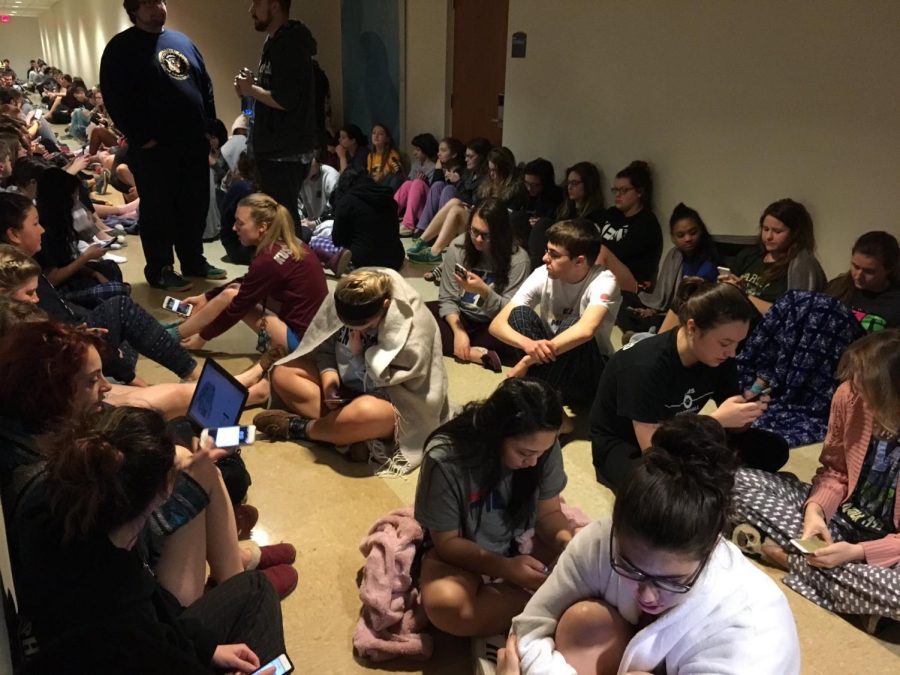Take cover: Tornado season begins
March 1, 2017
As if on cue, the first day of tornado season kicked off with sirens sounding in Kent around 6 a.m. on Wednesday.
Some students living on campus — like Sirya Banks, a sophomore sports administration major — said this was the first tornado warning she experienced and felt unprepared.
“I know it’s rare for tornadoes to happen, but this is a case where it did happen and no one knew what to do,” Banks said.
Tornado in Portage County affects students in resident halls from KentWired.com on Vimeo.
Students living in Kent State’s dorms awoke to city sirens and their residence hall alarms Wednesday morning. Each residence hall has an alarm system that notifies students of tornado warnings and directs them to seek shelter in the lowest level of the building.
If it weren’t for Leebrick Hall’s alarm system, Banks said she would not have woken up and headed to a crammed first floor. Banks said that fitting all 12 floors of Leebrick residents into one hallway was “rough and not ideal.”
“I slept through the city’s sirens, but as soon as the alarm and flashing lights went off in my room, I was up,” Banks said. “(I) ran out of the room (and) soon after I got there — since so (many people) were in the hallway — some people even had to go into the bathroom.”
Although residence halls have alarm systems, Olivia Johnson, a junior middle childhood education major, said she felt unprepared as well.
“We practiced this as a kid and I know if there isn’t a basement, going (into) a bathroom or a lower level away from windows is what you do,” Johnson said. “However, there was confusion today. It’s never been talked about before, though, so I just had to guess what to do.”
Thomas Schmidlin, a geography professor whose focus is on tornado hazards, said he wished Kent State had drills to teach students what actions to take when tornado warnings occur.
The City of Kent tests its sirens twice a month on the first Wednesday at 11 a.m. and the third Wednesday at 6 p.m., according to the city’s website.
Kent State does not participate in any drills or testing when these alarms go off.
“We practice fire drills, but we don’t practice tornado drills in college,” Schmidlin said. “I’ve advocated that once a year, at 11 (a.m.) on that day when the sirens go off, we ought to all go to shelter.”
Schmidlin said the fire department should walk through the building the way it’s done during fire practice to make sure everyone is safe.
While Northeast Ohio isn’t like Oklahoma or Texas when it comes to the number of tornadoes per year, that doesn’t mean such an event never happens in or around Kent.
“We’re in a medium risk on the national scene and the risk is greater to the Midwest and West,” Schmidlin said. “We’re vulnerable enough that everybody should be aware of what to do and campuses especially are vulnerable because there are so many people clustered in one place.”
Schmidlin noted that the Ohio Spring Severe Weather Awareness Week usually occurs during Kent State’s spring break. This year, it falls on March 19 through 25, which is one week before spring break.
“Ohio’s tornado safety week often occurs during the university’s spring break, so the campus misses out on that too. So all those activities and news items that come out about tornado safety get missed,” Schmidlin said. “But if you keep reminding people about hazards, that’s good because they tend to forget about if after a few years without reminding them.”
Johnson agreed that more awareness and communication would be beneficial when it comes to tornado safety on campus.
“I knew in this situation that I had to go to the lowest level, but I wasn’t sure what the building procedure is,” Johnson said. “We do enough drills in (high) school. But in college, it would be nice to be told what the procedure is at least once here.”
With the sirens going off as early as they did, a majority of students were in residence halls or not on campus yet. Schmidlin said no matter where someone is, it is important to be aware at any place and any time the potential for severe weather to happen.
“The university needs to think about what to do when there are lots of people in one building, like at an event at the (M.A.C. Center) later in the day,” Schmidlin said. “When the warning goes off, it’s a good time for people to think, ‘What would I do right here, right now?'”
Banks said she doesn’t think often about what they would do in the event of a tornado.
“I don’t know what to do anywhere on campus besides my dorm,” Banks said. “I’ll probably just always follow the crowd and hope for the best.”
Lack of knowledge could lead to students going outside during severe weather and heading to their cars or dorm rooms, but Schmidlin said going outside could be the worst decision to make.
“Going outside (during a tornado is) counterintuitive when lightening and everything else is going to be a problem,” Schmidlin said. “We have a lot of sturdy buildings (on campus). (Everybody) is better off in one of these buildings than they are at home. Any campus building is an engineered structure that won’t just blow down.”
Johnson said she would feel “much safer” with more preparedness.
“Everyone was unsure of the exact procedure today and I was even trying to think if there was a pamphlet on what to do,” Johnson said. “I think having a better plan is important and necessary.”
Sarah Heber is the safety reporter, contact her at [email protected].

























